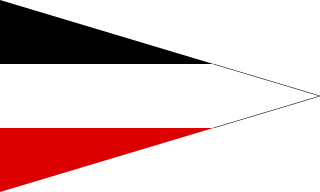The 1st Cavalry Division was a regular Division of the British Army during the First World War where it fought on the Western Front. During the Second World War it was a first line formation, formed from Yeomanry Regiments. It fought in the Middle East before being converted to the 10th Armoured Division.

The Guards Cavalry Division (Garde-Kavallerie-Division) was a unit of the German army that was stationed in Berlin. The division was a part of the Guards Corps (Gardekorps).
The 3rd Division was a unit of the Prussian/German Army. It was formed in Stettin in May 1816 as a Troop Brigade (Truppen-Brigade). It became the 3rd Division on September 5, 1818. From the corps' formation in 1820, the division was subordinated in peacetime to the II Army Corps. The 3rd Division was disbanded in 1919 during the demobilization of the German Army after World War I.
The 3rd Cavalry Division was a division of the British Army in the First World War. It was formed at Ludgershall, Wiltshire England in September 1914 under the command of Major-General the Hon. Julian Byng. The division moved to Belgium in the first week of October 1914, landing at Ostend, although its third Brigade was only formed once there. During the war the division took part in most of the major actions where cavalry were used as a mounted mobile force, and also many where the troops were dismounted and effectively served as infantry.

The 2nd Cavalry Division was a unit of the German Army in World War I. The division was formed on the mobilization of the German Army in August 1914. The division was disbanded in 1919 during the demobilization of the German Army after World War I.

The 3rd Cavalry Division was a unit of the German Army in World War I. The division was formed on the mobilization of the German Army in August 1914. The division was disbanded in November 1916.

The 9th Cavalry Division was a unit of the German Army in World War I. The division was formed on the mobilization of the German Army in August 1914. The division was dissolved in March 1918.

The Bavarian Cavalry Division was a unit of the Royal Bavarian Army, part of the German Army, in World War I. The division was formed on the mobilization of the German Army in August 1914. The division was disbanded in 1919, during the demobilization of the German Army after World War I. The division was raised and recruited in Bavaria.

The 6th Cavalry Division was a unit of the German Army that fought on Eastern and Western Fronts during World War I. The division was formed on the mobilization of the German Army in August 1914 and was disbanded in 1919 during the demobilization of the German Army after World War I.
The history of the German Cavalry in World War I is one of an arm in decline.
The 13th Army Corps was a corps of the Imperial Russian Army, formed in the 1870s. The corps fought in the Russo-Turkish War and World War I, and was disbanded with the collapse of the Imperial Russian Army after the Russian Revolution. During peacetime, it was stationed in the Moscow Military District.
The 4th Cavalry Division was a cavalry formation of the Russian Imperial Army.
The 6th Cavalry Division was a cavalry formation of the Russian Imperial Army.
The 11th Cavalry Division was a cavalry formation of the Russian Imperial Army.
The 13th Cavalry Division was a cavalry formation of the Russian Imperial Army.
The 14th Cavalry Division was a cavalry formation of the Russian Imperial Army.
The 15th Cavalry Division was a cavalry formation of the Russian Imperial Army.
The 8th Cavalry Division was a cavalry formation of the Russian Imperial Army, part of the 8th Army Corps. It was headquartered at Kishinev by 1914.
The 9th Cavalry Division was a cavalry formation of the Russian Imperial Army.
The 10th Cavalry Division was a cavalry formation of the Russian Imperial Army.


